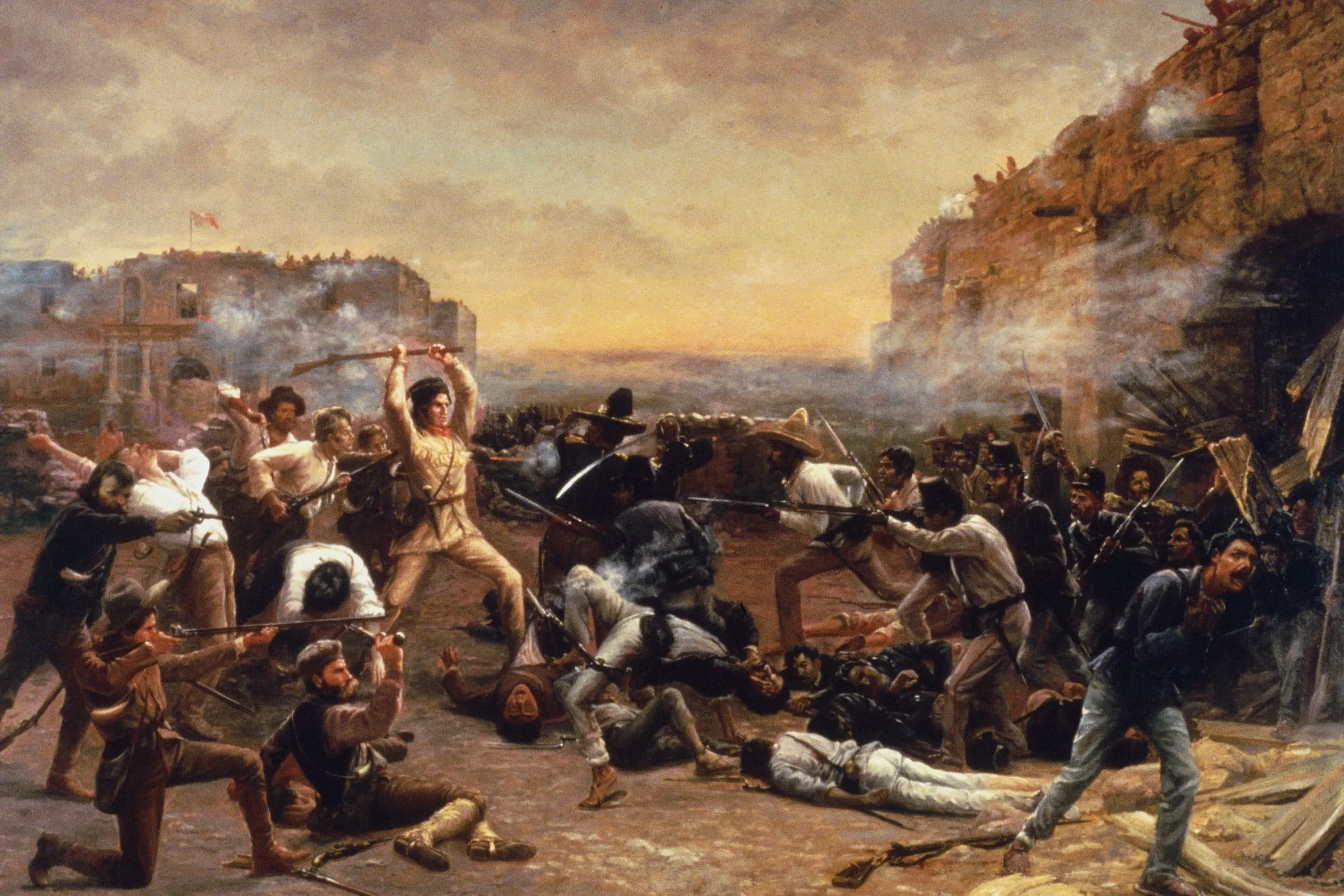The Texas Revolution was full of dramatic moments and bold individuals. Some names, like Sam Houston and Davy Crockett, are famous, while others played critical roles that are less well known. Each story below is told simply in three short parts: before the revolution, during it, and afterward.
Sam Houston
Sam Houston was born in Virginia and grew up on the frontier of Tennessee. After serving in the War of 1812, he became a politician, eventually serving as governor of Tennessee. After a personal crisis, he moved to Texas in 1832, just as tensions with Mexico were rising.
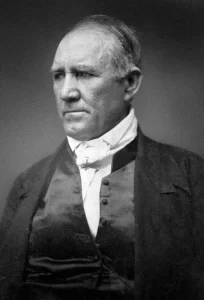
During the revolution, Houston was chosen to lead the Texian army. He organized a retreat across Texas, buying time to train his forces. On April 21, 1836, he led them to victory at the Battle of San Jacinto, capturing Santa Anna and ending the war.
After the revolution, Houston became the first president of the Republic of Texas. He later served as a U.S. senator and governor of Texas. A strong Unionist, he refused to support the Confederacy during the Civil War and remains one of Texas’s most respected figures.
Stephen F. Austin
Stephen F. Austin, known as the “Father of Texas,” led the first group of American settlers into Mexican Texas. He worked for years to negotiate peacefully with Mexican officials and helped establish strong Anglo-American communities.
Austin opposed a rush to revolution but changed his mind after being jailed by Mexican authorities. During the early stages of the revolution, he helped organize support for Texas in the United States. After independence, Austin served as Secretary of State for the Republic of Texas. Sadly, he died of pneumonia in 1836, only months after Texas won its freedom. The city of Austin was later named in his honor.
William B. Travis
William B. Travis was a young lawyer from Alabama who moved to Texas in 1831. He quickly became active in the growing resistance against Mexican rule, earning a reputation as a fiery leader.
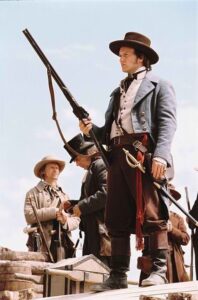
During the revolution, Travis commanded the Texian forces at the Alamo. In the face of overwhelming odds, he famously called for “Victory or Death.” He was among the first defenders killed when the fort fell on March 6, 1836.
Travis’s death made him a symbol of Texas courage. His stand at the Alamo inspired Texians to continue fighting, and his legacy is honored throughout Texas today.
Davy Crockett
Davy Crockett was a famous frontiersman and former U.S. congressman from Tennessee. After losing reelection, he decided to seek a new start in Texas, arriving just as the revolution was beginning. Crockett fought at the Alamo alongside Travis and Bowie. Known for his good spirits and bravery, he helped defend the fort during the final assault before being killed.
Crockett became a larger-than-life figure after his death, remembered as a hero who stood for freedom. His story has been retold in songs, books, and movies ever since.
James Bowie
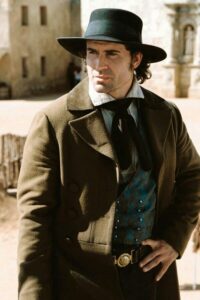
James Bowie was a frontier adventurer known for his famous knife and rough reputation. He moved to Texas in 1830, married into a prominent Mexican family, and became involved in land and political affairs. Bowie helped lead Texian forces during the early revolution. At the Alamo, he fell seriously ill during the siege and was killed during the final attack while bedridden.
Bowie’s daring life and tragic death became part of Texas legend. His name lives on in the famous “Bowie knife” and in many places across the state.
James Fannin
James Fannin was a Georgian who moved to Texas and joined the fight for independence. He struggled with leadership but was respected by many of his men.
Fannin commanded Texian forces near Goliad but was forced to surrender after being surrounded by Mexican troops. Despite surrendering under terms of fair treatment, he and about 350 of his men were executed in the Goliad Massacre.
“Remember Goliad!” became a rallying cry for Texian forces. Fannin is remembered today as a martyr whose death helped inspire the final Texian victory at San Jacinto.
Juan Seguín
Juan Seguín was a Tejano political leader from San Antonio who supported federalist reforms in Mexico before siding with Texians against Santa Anna’s dictatorship. Seguín fought at the Siege of Béxar and served as a courier from the Alamo. He later commanded Tejano forces at the Battle of San Jacinto, helping secure Texas’s independence.
After the war, Seguín became mayor of San Antonio, but anti-Tejano sentiment forced him into exile. He eventually returned to Texas, and today the city of Seguin is named in his honor.
Benjamin R. Milam
Benjamin Rush Milam was born in Kentucky and fought in the War of 1812 before becoming involved in land deals in Mexico and Texas. He supported Mexican independence from Spain and even became a Mexican citizen, but over time grew frustrated with Santa Anna’s dictatorship and joined the Texian cause.
During the revolution, Milam became a fiery advocate for action. In December 1835, when Texian forces were hesitant to attack San Antonio, he famously stepped forward and shouted, “Who will go with old Ben Milam into San Antonio?” His call inspired hundreds of men to follow him. Milam led the charge during the Siege of Béxar, a critical early Texian victory, but was killed by a sniper during the battle.
Milam’s bold leadership and dramatic final stand made him a symbol of Texian courage and determination. He is honored across Texas today, with Milam County and many schools and streets named after him.
Susanna Dickinson
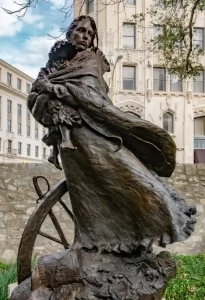
Susanna Dickinson was a young settler who came to Texas with her husband, Almaron Dickinson. When fighting broke out, she joined him inside the Alamo with their infant daughter. Susanna survived the fall of the Alamo and was sent by Santa Anna to tell the Texians about the defeat. Her story helped rally Texian forces to continue the fight.
Life after the revolution was difficult, but Susanna eventually remarried and settled in Austin. She remains a symbol of survival and resilience in Texas history.
Lorenzo de Zavala
Lorenzo de Zavala was a Mexican politician who supported democracy and federalism. Disillusioned with Santa Anna’s dictatorship, he moved to Texas and supported the independence movement. De Zavala signed the Texas Declaration of Independence and served as the Republic of Texas’s first vice president. He helped shape the early government during its most critical days.
Sadly, he died of pneumonia only months after Texas won its freedom. Zavala is honored as a bridge between Hispanic and Anglo Texans in the fight for liberty.
Thomas Rusk
Thomas Rusk was born in South Carolina and worked as a lawyer in Georgia before moving to Texas in 1834. He came to Nacogdoches to recover funds stolen from a business deal but stayed after becoming inspired by the fight for Texian independence. During the revolution, Rusk played several important roles. He helped lead troops during the Runaway Scrape and fought at the Battle of San Jacinto. He also served as Secretary of War for the new Republic, helping organize the military after independence was won.
After the revolution, Rusk remained deeply involved in Texas politics. He helped write the Republic’s constitution, served as chief justice of the Texas Supreme Court, and later became a U.S. senator. A close ally of Sam Houston, Rusk worked to bring Texas into the United States and is remembered as one of the founding leaders of the state.
